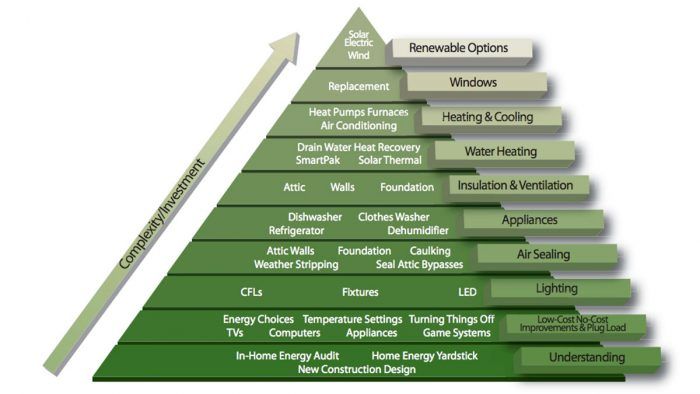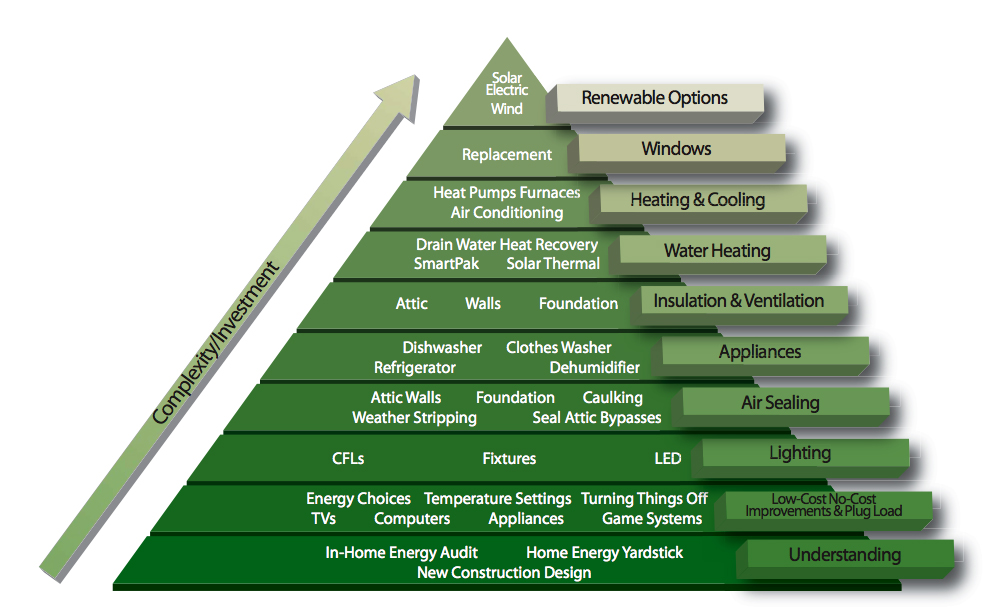10 Ways to Cut Utility Bills
Energy nerd Martin Holladay presents a ten-step program that's guaranteed to reduce your electricity and heating fuel costs.

The ten steps are not set in stone; every house is different, and different climates may dictate different strategies, which will be determined as soon as you take the first step.
1. Get a Home Energy Audit
Before beginning any energy retrofit work, have a home energy audit done to identify and prioritize problem areas.
A good home energy audit always includes a blower-door test. To be sure your auditor is well trained, choose one certified by RESNET or BPI.
The audit can cost as much as $600. Subsidies are available from some utilities and local governments, so check there first. Why spend money on an energy audit?
- When considering energy retrofit work, most homeowners prioritize the wrong steps. An energy audit provides valuable information to counterbalance misleading advertising pitches for worthless products.
- Your audit is likely to reveal unseen defects in your home — for example, thermal bypasses (air leaks) through convoluted, hidden chases, or insulation gaps revealed by an infrared camera.
- At the end of your audit, you’ll receive a customized list of the most important energy retrofit steps for your house — a list that may differ from your assumptions (or even from the recommendations of the energy conservation pyramid).
- By identifying the most important retrofit tasks for your specific house, a good audit can save you hundreds of dollars that might have been wasted on inappropriate work.
2. Unplug and Turn Off
This step, though obvious, is often neglected: turn things off.
Inattention and laziness are responsible for a significant amount of energy waste; this step off can yield significant savings for a very small investment. To lower your electric bill:
- Turn off the lights when you leave a room.
- Turn off appliances that aren’t being used.
- When not in use, unplug chargers for cell phones and similar battery-operated gadgets.
- Put televisions and other “instant on” appliances on a plug strip — and remember to turn off the plug strip when the appliance isn’t in use, because these appliances use power even when not turned on.
3. Use Efficient Light Bulbs
The next step is very cost-effective: make sure your house is incandescent-free. LED bulbs use a fraction of the energy that an incandescent does. LEDs have been around long enough that most incandescents—even in older homes—have probably been replaced by now, but you still may have some old inefficient bulbs knocking around, so check your fixtures.
4. Seal Air Leaks
Air-sealing work is best done by an experienced home-performance contractor equipped with a blower door. Although this step usually costs hundreds of dollars, it will usually yield a quick payback in energy savings.
Air sealing work is not the same as caulking. Many homeowners have spent hours wandering around their house with a caulk gun — on the interior, filling cracks between window trim and plaster, or on the exterior, filling cracks between clapboards. Most of this caulking is a total waste of time. In fact, by trapping water, most exterior caulking does more harm than good.
Blower-door directed air sealing work is usually concentrated in a home’s basement (especially at the rim-joist area) and attic (where huge thermal bypasses are often hidden under a layer of fiberglass batts). Most air leaks are best addressed with two-component spray polyurethane foam.
5. Replace Inefficient Appliances
Once you’ve paid for blower-door-directed air sealing, it’s time to take a close look at your appliances. If some of your major appliances—your refrigerator, clothes washer, or dishwasher—are more than ten years old, you may want to replace them with more efficient models.
Don’t be tempted to buy a bigger refrigerator; small is good. Pay close attention to the yellow EnergyGuide labels — especially the annual kWh number — when you go appliance shopping.
6. Improve the Insulation
Ideally, your home has plenty of insulation in the attic, above-grade walls, and basement walls. But if you’re insulation isn’t up to snuff, it’s well worth improving it.
In colder climates, it makes sense to install R-60 insulation in your attic — as long as the attic is accessible and roomy enough to accommodate the insulation depth.
If your stud bays are empty, they can be filled with dense-packed cellulose insulation installed through holes drilled from the exterior.
Basement walls can be insulated on the interior with rigid foam insulation or closed-cell spray polyurethane foam.
7. Replace an Inefficient Water Heater
If the configuration of your home’s plumbing pipes permits, you should install a drainwater heat-recovery device — especially if members of your family prefer showers to baths.
If you have an old, inefficient water heater, you may wish to replace it. Options include:
- A high-efficiency gas-fired water heater
- A high-efficiency electric resistance water heater
- A heat-pump water heater
- An instantaneous gas-fired water heater
- An indirect water heater connected to a boiler
- Any of the above, supplemented by a solar water heater
Of all of the options listed in this section, the fastest payback will probably come from the drainwater heat-recovery device. Although a new water heater can lower your energy bills, you shouldn’t expect a fast payback on the investment.
8. Improve on Space Heating and Cooling Equipment
When inefficient heating and cooling equipment gets old enough to replace, be sure to invest in the most efficient available equipment. If you’re shopping for a new furnace, look for a high AFUE (in the 90s). If you are shopping for a new air conditioner, look for high SEER (14 or higher).
There’s an important reason why energy-efficiency experts recommend holding back on the purchase of new heating and cooling equipment until air sealing and insulation work is complete: envelope improvements may permit heating and cooling equipment to be downsized. If you replace your heating and cooling equipment before finishing necessary air-sealing work or insulation upgrades, you’ll waste money on oversized equipment.
9. Insulate or Replace Windows
We’ve now reached the top of the pyramid. Further measures will probably reduce your home’s energy consumption, but they are unlikely to be cost-effective. The reason these measures are at the top of the pyramid is that few homeowners want to spend more on retrofit work than they will ever see in savings.
In a heating climate, the installation of low-e storm windows is more cost-effective than installing new replacement windows.
If, for reasons unrelated to saving money, you insist on new windows, be sure to choose windows with low-e glazing. Glazing with a low U-factor is desirable in all climates. In climates with cold winters, south-facing windows should have a high solar heat-gain coefficient (SHGC); in climates where air-conditioning bills are high, windows should have a low SHGC.
10. Invest in Wind or Photovoltaic Systems
At the top of the pyramid is the category of work least likely to provide a payback: the installation of a photovoltaic system or a wind turbine. There are many reasons you may want to have PV panels or a wind turbine, but saving money isn’t one of them.
Remember, it makes no sense to invest in an expensive PV system until after you have invested in all of the other measures listed on the pyramid.
No Silver Bullet
One of the Minnesota Power representatives who makes regular use of the conservation pyramid is Dean Talbott, a program manager for the utility.
“I handle a lot of customer calls, and lately I’ve seen a growing interest in renewable energy,” Talbott told me. “A lot of callers are looking for the silver bullet. I just got a call this week from a residential customer who’s spending $200 a month on electricity, and he told me he wants to install solar and wind. I told him he’d be better off to start with efficiency upgrades first.”
Fine Homebuilding Recommended Products
Fine Homebuilding receives a commission for items purchased through links on this site, including Amazon Associates and other affiliate advertising programs.

Pretty Good House

Musings of an Energy Nerd: Toward an Energy-Efficient Home

A Field Guide to American Houses

The energy-saving measures at the base of the pyramid give you the biggest bang for your buck. Click to enlarge.






View Comments
I was surprised not to see anything about using a programmable thermostat. Because you can get it to start heating your house early enough so it’s already comfortable when you get up, you can afford to set the overnight temperature way back, saving lots of energy. A 7-day programmable thermostat can accommodate odd schedules such as 3-day work weeks and so on; other simpler-to-program ones allow you one schedule for weekdays and another for weekend days. The myth that if you set a thermostat too low you’ll use more energy reheating the house than you’ve saved, is false both in scientific theory and reality.